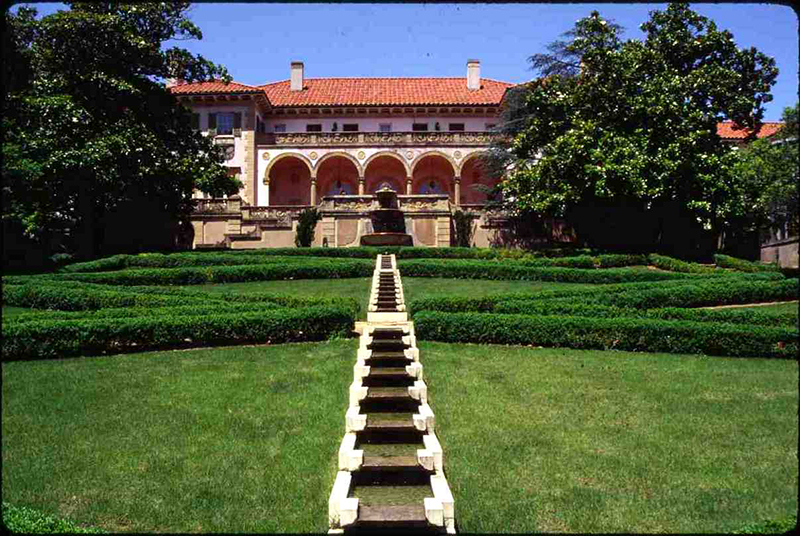
The Encyclopedia of Oklahoma History and Culture
PHILBROOK MUSEUM OF ART.
Waite and Genevieve Phillips established the Philbrook Art Museum (now The Philbrook Museum of Art) in 1938, through the donation of their Tulsa residence, Villa Philbrook, to the community of Tulsa. They envisioned that Philbrook would become a cultural institution "housing, preserving, and displaying therein works of art, literature, relics and curios, including those representative of the native North American Peoples." Following a major remodeling of the residence, Philbrook opened its doors on October 25, 1939, under the leadership of its first director, Eugene Kingman.
Philbrook expanded upon the educational programs previously offered by the now-defunct Tulsa Art Association, initiating studio art classes in 1940 and a touring program for school children the following year. The latter was further enhanced with the establishment of the Children's Museum in 1949, which doubled in size by 1952. This program, developed in collaboration with the Junior League of Tulsa, brought all fifth- and sixth-grade students in the Tulsa public schools to Philbrook to study the art and culture of another country. A similar cultural touring program, as well as tours of the permanent collection and special exhibitions, continued into the twenty-first century. To meet the increased demands throughout the 1960s and 1970s for studio art classes, a new museum school wing was built in 1969. However, as enrollment declined in the 1990s, this aspect of the educational program was deemphasized, and more focus was placed on the educational needs of the public schools, such as working with at-risk classes on the fundamentals of visual arts.
The original basis for the museum's permanent collection consisted of a few works of art formerly belonging to the Tulsa Art Association as well as artworks that were part of Philbrook's original furnishings. The corpus has grown steadily through purchase and donation, particularly the latter. American Indian objects have always been a major component, in large part because of the gifts of American Indian pottery and basketry from Clark Field beginning in 1942 and the Roberta Campbell Lawson collection in 1947. The University of Tulsa's long-term loan and eventual transfer of ownership of several collections further strengthened the museum's holdings of American Indian art. The American and European collection, which received a major boost with the gift of European and American paintings by Laura A. Clubb in 1947, was further enhanced with the long-term loan and eventual gift in 1961 of Italian Renaissance paintings and sculptures from the Samuel H. Kress Foundation. Related holdings of works on paper also received major gifts of prints from Mr. and Mrs. Herbert Gussman in 1980 and the Robert and Barbara Huff collection in the late 1990s. The Asian, African, and antiquities collections have also broadened the museum's scope. The first has been shaped by gifts of the George H. Taber Chinese collection of ceramics and jade in the 1950s, the Shinenkan Japanese screen and scrolls in 1966, and Southeast Asian ceramics from Pete and Velma Gillert in the late 1970s. Lawrence and Herbert Gussman have been largely responsible for the development of the African focus with regular gifts between 1966 and 1982.
The exhibition program has always been an important aspect of Philbrook's mission. Initially, the museum continued the efforts of the Tulsa Art Association to exhibit local and regional artists, establishing the yearly competitions known as the Oklahoma annual (1940–76), the Tulsa annual (1945–52), and the Indian annual (1946–79). Philbrook gained a national reputation from the Indian annual, acquiring from it many of the paintings now in its acclaimed American Indian collection. The Indian annual was important in bringing Indian artists' works to the public eye and into many private and public collections across the country. The establishment of the Collector's Group at Philbrook and its annual sale exhibition, Collector's Choice, held throughout the 1960s and 1970s, further encouraged people to acquire art. By the late 1970s the focus of the exhibition program shifted, as Philbrook reduced its emphasis on local artists. Instead, the museum began bringing national traveling exhibitions to the region, as well as organizing its own traveling exhibitions, such as Painters of the Humble Truth (1981) and The Eloquent Object (1987).
Philbrook's long-time director Marcia Manhart oversaw the difficult financial times of the 1980s and the renaissance of the 1990s. The latter is symbolized by the name change in 1987 from the Philbrook Art Center to The Philbrook Museum of Art. The new Kravis Wing opened in 1990, and a major renovation of the permanent collection galleries in the original Villa Philbrook was completed in the following year. At the beginning of the twenty-first century the museum continued in its mission to collect, preserve, and educate in relationship to the visual arts.
See Also
GILCREASE MUSEUM, ROBERTA E. CAMPBELL LAWSON, NATIONAL COWBOY AND WESTERN HERITAGE MUSEUM, WAITE PHILLIPS






